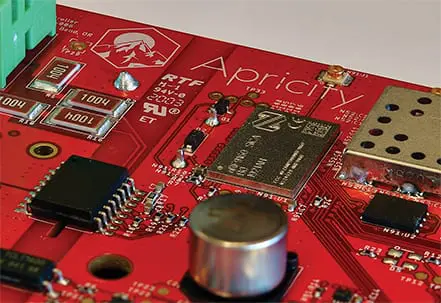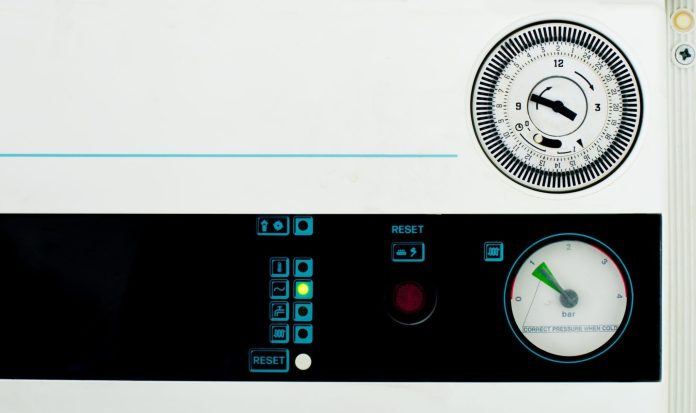US engineering and product design agency Apricity has devised a combined LTE-M and BLE solution for utilities in the US to control demand from domestic water heaters and reduce supply from coal-fired auxiliary power stations.
Domestic water heaters are estimated to be responsible for up to 20 percent of power usage per house in the US, according to Nordic Semiconductor, which provided the LTE-M module into the final solution. A good deal of that 20-percent figure is wasted energy.
Water heaters in the US are often manually operated, and generally left powered-on through the day, even when not in use. The introduction of connected IoT controllers means they can be remotely switched on and off by utilities, according to demand.
 Apricity’s new power controller device uses both LTE-M and Bluetooth Low Energy (BLE) to give remote control over domestic water heaters to power utilities and reduces unnecessary drain on power, which is supplemented by polluting coal-fired stations in many regions.
Apricity’s new power controller device uses both LTE-M and Bluetooth Low Energy (BLE) to give remote control over domestic water heaters to power utilities and reduces unnecessary drain on power, which is supplemented by polluting coal-fired stations in many regions.
In particular, the new Apricity IoT controller, called Ara, was developed in response to challenge by an unnamed local authority in the US to local utility companies to cut power consumption in order to enable it to close down a coal-based power station.
The Ara unit, which attaches in-line with the power supply of each water heater, makes use of both LTE-M and BLE wireless mesh networking. Apricity said cellular low-power wide-area (LPWA) technologies like LTE-M afford a simpler and more reliable performance than rival non-cellular LPWA technologies.
The inclusion of BLE, meanwhile, guarantees coverage in environments with poor LTE-M coverage such as in basements, the company said. The signal, with the control data, is relayed in both directions via the BLE mesh network to a water heater with an LTE-M connection, to the cloud control system with the utility.
Apricity said, with the new control system, the water in the heating tanks remains near optimal temperature but unnecessary electricity consumption during peak periods is minimised, avoiding spikes in demand. This increases the inefficiency of power grids and reduces demand for auxiliary power.
Whether or not the local authority and local utility in question has been able to switch off their auxiliary power is unclear. However, Apricity said it is “helping multiple power utilities in pilot field studies throughout the US.”
It reckons its Ara solution – based on Nordic Semiconductor’s nRF9160 LTE-M/NB-IoT system-in-package and nRF52840 system-on-chip, is unique as a dual-mode wide-area and short-range IoT solution, which can achieve a price point to deliver massive volumes (“hundreds of thousands of units”).
Jacob Betcher, chief operating officer at Apricity, said: “Tanked water heaters are often installed as always-on devices with no user- or demand-based control and so they continually consume energy reheating the water. During times of peak electricity demand, asking dormant hot water heaters to temporarily reduce their energy consumption is a very effective power load reducing method.
“With some simple local monitoring, it is possible to allow water heaters in-use to continue heating, while reducing standby heating of water heaters not in use.”
He added: “Hot water tanks are in effect an energy storage medium and by making a large number smart you are effectively creating a huge energy storage tank. You can ‘charge’ this in a much more optimal way if allowed to have some control over which times of day the tank is actively heating stored water.”
Evan Biskey, engineer at Apricity, commented: “While non-cellular wireless water heater controllers exist, they are less reliable… [Utilities have] not only been required to set-up and install, but also to maintain the wireless connection because the gateway could periodically go down.
“Part of the reliability of cellular comes from the fact it does not require a gateway, and leverages strong commercial cellular networks. This has enabled us to make our solution ‘fit and forget’, and is why we included a proprietary mesh capability to supplement the cellular connectivity and push the reliability uptime figure as high as possible.”
Geir Langeland, director of sales and marketing at Nordic Semiconductor, said: “One of the biggest challenges in the energy industry is that local power grids can’t store excess energy and have to buy-in expensive power from other grids to meet peak demand to avoid brownouts and blackouts. This application demonstrates how cellular IoT can be used to spread demand out and reduce energy consumption and costs for both consumers and utilities.”

